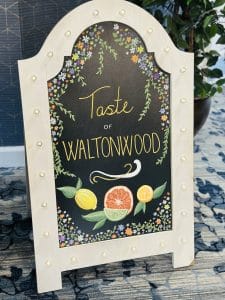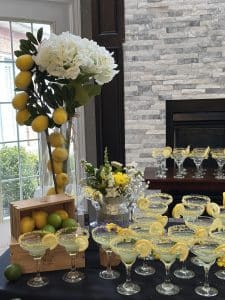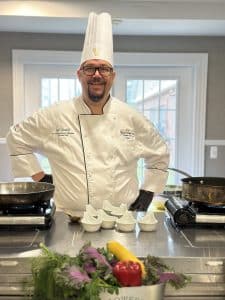 Anyone wondering about the importance of dining to senior living simply needs to observe a meal being served in a community. Whether it’s on a white tablecloth in an elegant dining room or at an outdoor barbecue celebrating a holiday or during happy hour at a bar, the dining experience is a treasured component of senior living – and its role may be growing even more in the years ahead.
Anyone wondering about the importance of dining to senior living simply needs to observe a meal being served in a community. Whether it’s on a white tablecloth in an elegant dining room or at an outdoor barbecue celebrating a holiday or during happy hour at a bar, the dining experience is a treasured component of senior living – and its role may be growing even more in the years ahead.
“When you dine in our community, it’s easy to see how meaningful meals are to our residents,” said Kara Terreault-Triplett, director of culinary services, Waltonwood Senior Living. “More than just nourishment, mealtimes are celebrated as social gatherings — opportunities to catch up with friends, connect with neighbors and share time with our dedicated associates.”
As communities lean into the central, vital role that dining plays to their residents, they are investing more into finding new ways to serve residents and meet their rapidly evolving expectations. Communities consequently are offering a greater variety of experiences, all while striving to better serve the unique needs and preferences of individual residents. The result is that dining experiences in senior living are becoming increasingly sophisticated and diverse.
“There are a lot of exciting things happening right now,” said Steven Fowler, vice president of operations at Vi Living. “Over the last three years, I think there’s been more of a focus shift in the industry across all venues to bring more of a restaurant-style experience to dining. It’s a big change from what was once very institutional and maybe more of a structured cycle of menus that were very predictable. When I’ve been to conferences lately and listened to panelists speak, it has been around that question of ‘Okay, how can we really up the quality and the freshness of what we’re doing to mirror what’s happening in restaurants?’”
‘Everyone eats’
There is little question that the dining experience holds a prominent place in senior living. For providers, every meal is an opportunity to serve their residents and enrich their daily lives.

Fowler said food and dining play a notable role in socialization and relationship development – not just between residents but between residents and staff. Dining creates experiences that drive and strengthen those connections, he said.
“Food is a focus point for a lot of great experiences in a community,” Fowler said.

“And I think it’s going to be more and more important,” he said.
After all, Terreault-Triplett said, “food is deeply personal.” Prospective residents on tours always want to know about the food for good reason, she said.
“The chicken noodle soup I grew up loving might not be the same as the one you remember from your childhood,” Terreault-Triplett said. “That’s why it’s so important to stay flexible and respectful of each person’s tastes and preferences. When someone is choosing a community to join, they want to know they will fit in and will enjoy every aspect of their new community — especially the food.”
Variety and choice is crucial
Fowler said he has seen an increased focus on offering variety in senior living dining and searching for how different types of dining might resonate with residents. “Residents are moving in and they don’t want just a single experience or a single style of preparation, and they don’t want a single style of service,” Fowler said.
“There’s been an awareness that if we really want to market to a luxury type of environment, a luxury experience, a very high-end experience for residents that are moving into these communities, it cannot be simple – that’s just not going to satisfy them anymore,” Fowler said. “There’s a more discerning clientele, and they want what they want, and they know what they want.”
If communities today fall into recycling meals too often or their menu starts to feel stale, residents are going to pick up on it, Fowler said.
“It’s about having a constant commitment toward variety and evolution,” Fowler said.
As Lonoza noted, residents deserve to have choices, and “variety is the most direct way to support autonomy, lifestyle and personal identity.” For instance, Ellore’s dining venues include The Summit Room, which offers an outdoor terrace for al fresco dining; several private dining spaces; and a bar and lounge.
“Multiple venues allow us to meet residents where they are, whether they want a casual lunch, a quiet breakfast or an evening experience with friends or family,” Lonoza said. “Across every setting, we hold the same standard of culinary excellence, ensuring that quality and care are never
compromised.”
In addition, Lonoza said technology helps communities offer high-end dining and service to residents “where and when they want it.”
“Online ordering allows residents to order from their phone and have food and drinks delivered to their home or poolside,” Lonoza said.
Offering a compelling variety of food options for residents means meeting their evolving expectations – expectations they are bringing to communities from changing trends in food culture.
“Residents today expect more than nutrition,” Lonoza said. “They expect flavor, flexibility and wellness-driven options that reflect how they eat outside of senior living.”
Terreault-Triplett said senior living falls in step with a broader shift in eating and nutritional philosophy toward eating more plant proteins and adopting a more vegetarian-based diet for health considerations – steering away from the meat-and-potatoes diet that prevailed for generations.
“Our residents are starting to take the medical advice of eating more whole vegetables and seeking protein from meat alternatives,” Terreault-Triplett said. “As generations age, I think this will continue to grow over time and the industry is starting to meet these changes, and forming offerings that will continue to be sought after in the future.”
Similarly, Lonoza said Ellore has built programs around longevity-focused cuisines, regional identity and ingredient-driven cooking “that respects both taste and health.”
Ultimately, senior living communities are seeking to strike a complex balance for their residents.
“Our goal is to always have a wide range of options, so every resident can find something they can enjoy,” Terreault-Triplett said. “While every meal may not be their favorite, it inevitably will be another resident’s favorite, so our mission is to try and find that balance that pleases our residents over the course of time and different offerings. Preferences are very important, especially when it comes to customer service and at Waltonwood, we work hard to meet preference requests, while understanding that one’s preference may be another’s dislike.”
The emphasis on variety, freshness and elevated food reflects a structural shift in senior living.
“When you’re moving into a place where you’re going to dine every day or many days of the week for years and years, you need to have some peace of mind that that meal is being prepared fresh in house and can be modified to what your needs or preferences are,” Fowler said. “So I think it’s just a realignment. Where before it was more ‘This is what we provide,’ now it’s ‘How can we provide something more to your liking?’”
‘A complete culinary experience’
Ellore is among the communities that has adopted a chef-driven approach to dining, Lonoza said.
“We have built a system where chefs lead the process, not just execute it, with full ownership of menu development and daily operations,” Lonoza said. “Our kitchens are held to a professional culinary standard, rooted in technique, balance and the ability to adapt to resident needs in real time.”
Ellore will offer multiple venues, rotating seasonal menus and dishes “that reflect both comfort and refinement,” Lonoza said. The goal, he said, is “a complete culinary experience.”

At Ellore, it is important that families and residents not merely see a menu but see “chefs who are trusted to lead, ingredients that reflect the region and meals that feel personal,” Lonoza said.
“We build food around the people we serve, not around systems, and that difference is immediately felt in the room,” Lonoza said. “Dining at Ellore is not an amenity; it is a living expression of how we earn trust, keep it and build lasting connections from the first visit forward.”
When families experience the Ellore dining program, Lonoza said they recognize “the level of care, pride and professionalism behind it.
“It communicates more than great food – it reflects our culture, our hospitality standards and the daily follow-through on what we promise,” Lonoza said. “From the first impression to ongoing satisfaction, dining plays a central role in building trust and belonging for every resident and family.”
Opportunities to ‘elevate’

“It’s a great, positive way to introduce new things and allow tastings, so we have less waste and a chance to sample new dishes,” Terreault-Triplett said. “We are also working on allergy and diet alternatives and how we can be more inclusive to residents and prospects that need different nutritional options. Our chefs are professionally trained, and we continue to offer trainings to our staff to grow their knowledge and ability to meet our resident’s needs.”
The Taste of Waltonwood is an annual campaign that celebrates the changing of the seasons and National Nutrition Month. The program showcases fresh ingredients and new menu items at Waltonwood communities.
“We hold events at all 12 of our locations, and the chefs utilize their spring menu to create a series of elevated tastings to help drive excitement with our residents, families and prospects,” Terreault-Triplett said. “It’s one of our largest, most anticipated events, and we continue to grow attendance and our offerings.”
Consistency in the approach to dining is critical, even as adjustments are made in the interest of keeping things fresh.
“One thing we strive to do is secure a strong foundation and deliver to the services we promise and provide,” Terreault-Triplett said. “While we make menu changes, our core service we provide doesn’t change. We want our residents to trust our culinary team and know that their enjoyment of food and nutrition is our utmost priority. Being dependable is a pillar throughout our communities, and when you serve over 1.5 million meals a year, you need to be committed to your program and residents.”
Among the other special dining-focused programs that Waltonwood hosts are chef demonstrations, where chefs prepare food live for residents to enjoy, and special occasions with themed dinners, such as for Mardi Gras and Halloween. Waltonwood also hosts grand buffet-style meals for major holidays.
“These gatherings are reminiscent of a country club atmosphere — complete with themed menus, decadent desserts and family participation,” Terreault-Triplett said. “These celebrations are truly special. They’re intergenerational, full of laughter, shared stories and a strong sense of community — all centered around an incredible meal.”
‘Always looking for something new’

Of course, in order to meet residents’ growing expectations, communities need talented and experienced chefs to meet or exceed those expectations. And those chefs need to feel inspired by the challenges and opportunities in senior living. Fowler said Vi takes its culinary teams to the Culinary Institute of America campus to ensure they are learning new food preparations and gaining new ideas to bring back. Similarly, Vi worked with its wine partners to bring its dining directors to Napa in 2024 to collaborate on developing curated meals and wine tasting experiences.
“You’re always looking for something new to inspire a new concept,” Fowler said. “It never ends.”
Vi’s commitment to freshness means everything from pastry chefs making fresh-from-scratch desserts and breads every morning to fish and meat being butchered in-house. “We’re not relying on vendors to process a lot of the ingredients that go into our dishes,” Fowler said. “It gives us the ability to be very flexible with how we build our menus and how much diversity we can really deliver.”
Fowler said Vi’s future dining includes hopes of bringing more immersive experiences for residents.
“In the past, it might have been more a passive engagement, where residents wanted to come in and have a four- or five-course dinner, and that was considered the expectation,” he said. “As we move to the future, fine dining certainly is still a part of it. People want to entertain. They want to have a great experience. But I think we’re looking to have more cooking demonstrations, cooking classes. And going a bit further, we’re actually having cultural education that has food components to it, querying our residents on what it is that they’ve enjoyed in travel that we might want to bring to those special theme nights. I think more engagement around how these experiences are planned out and executed is going to be part of the future of the new generation of residents joining our community.”
An exciting future
In light of all the attention and innovation happening in dining in senior living, those in the field are feeling energized by fresh possibilities.
“As a chef in senior living, I can’t stress enough how important the service is that we provide,” Terreault-Triplett said. “While every position has its challenges, I truly enjoy serving our seniors, and their families. It’s the best of both worlds. I am able to use my culinary skills, leadership and passion, while getting to learn the resident’s personalities and preferences. There are very few opportunities in food service as a whole to learn your clientele in this sort of closeness, while running a culinary operation.”
Looking ahead, Fowler said, “It’s a really exciting time to be working in senior living from a food and beverage perspective because of the amount of change and creativity that we’re going to have to bring to bear to be successful. We’re going to straddle two generations of residents that probably have very, very different tastes and preferences. And while it’ll be challenging, it’s going to be a lot of fun for our corporate-level staff to support the communities and the executive chefs and their teams to try some new things. It’s not all going to work. Some of it will be a one and done, but some of them will give us some traction to go new directions. I’m just really looking forward to the future and new opportunities to explore.”




